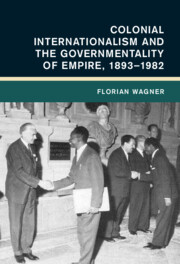Book contents
- Colonial Internationalism and the Governmentality of Empire, 1893–1982
- Global and International History
- Colonial Internationalism and the Governmentality of Empire, 1893–1982
- Copyright page
- Dedication
- Contents
- Figures
- Acknowledgments
- Abbreviations
- Introduction
- 1 “More Beautiful than the Nationalist Thought”?
- 2 A Transcolonial Governmentality Sui Generis
- 3 Politics of Comparison
- 4 Cultivating the Myth of Transcolonial Progress
- 5 The Adatization of Islamic Law and Muslim Codes of Development
- 6 Creating an “Anti-Geneva Bloc” and the Question of Representivity
- 7 Inventing Fascist Eurafrica at the Volta Congress
- 8 False Authenticity
- 9 “That Has Been Our Program for Fifty Years”
- Conclusion
- Bibliography
- Index
5 - The Adatization of Islamic Law and Muslim Codes of Development
Published online by Cambridge University Press: 14 January 2022
- Colonial Internationalism and the Governmentality of Empire, 1893–1982
- Global and International History
- Colonial Internationalism and the Governmentality of Empire, 1893–1982
- Copyright page
- Dedication
- Contents
- Figures
- Acknowledgments
- Abbreviations
- Introduction
- 1 “More Beautiful than the Nationalist Thought”?
- 2 A Transcolonial Governmentality Sui Generis
- 3 Politics of Comparison
- 4 Cultivating the Myth of Transcolonial Progress
- 5 The Adatization of Islamic Law and Muslim Codes of Development
- 6 Creating an “Anti-Geneva Bloc” and the Question of Representivity
- 7 Inventing Fascist Eurafrica at the Volta Congress
- 8 False Authenticity
- 9 “That Has Been Our Program for Fifty Years”
- Conclusion
- Bibliography
- Index
Summary
To manipulate Islamic law and use it for the purpose of “development,” ICI members declared it a customary law, as Chapter 5 unveils. The most famous amalgam of Islamic law and customary law was the adat law collected by ICI members in the Dutch Indies. Inspired by the adat law collection, ICI members created new legal codes for Muslim Africa, making the law more compliant to European necessities. Legal codes strategically combined elements from the four legal schools of Islam, customary law, and European law. In Africa, codifications of Muslim law served as an instrument to manipulate property law. One purpose was to expropriate habous land, traditionally inalienable land of Islamic endowments, which was often fertile and highly-prized. Hence, the misuse of Islamic law became a central tool for the ICI’s transcolonial governmentality. The codification projects show how ICI experts used their international networks to find the best strategy for reworking Islamic law in favor of colonialism. Colonial administrations, ICI experts recommened, should not fear Pan-Islamic movements, but should instead capitalize on cooperation with Muslims both inside and outside their territory. The expropriation of habous became so widespread that the Paris Peace Conference debated it in 1919.
Keywords
- Type
- Chapter
- Information
- Publisher: Cambridge University PressPrint publication year: 2022

